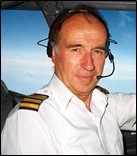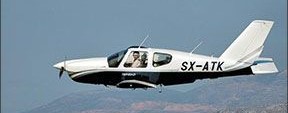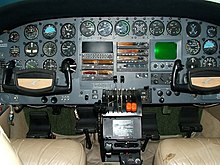
|
Vol 80 |
Page 14 |
|
Privacy Policy | Editorial Policy | Profit Policy | Join the Association | List of Members | Contact us | Index | Links |
|
Back Go to page: 1 2 3 4 5 6 7 8 9 10 11 12 13 14 15 16 17 18 19 20 Forward |
|
John Laming
Aircraft and other stuff. |
|
|
|
Is your Checklist really necessary?
I learned to fly in the Royal Australian Air Force on Tiger Moths and Wirraways. Our instructors were insistent about one thing in particular and that was we had to know all cockpit checks off by heart. Fumble a check and you were in trouble. Tiger Moth drills were simple while the Wirraway checks were more detailed.
After graduation as a RAAF pilot, postings could be to Mustangs, Vampires, Dakotas, Lincolns, or other types. Regardless of which aircraft one flew, the basic Central Flying School (CFS) drill applied, with perhaps a few extra items such as supercharger switches, automatic pilots, bomb door levers and gun safety switches. The perennial CFS (and thus RAAF) before take-off checks – known as Vital Actions — started with harness, hatches, hydraulics, trims, mixture, pitch and so on.
There were no official mnemonics, so those with a memory problem probably invented their own, to be muttered quietly under one’s beard, lest the instructor heard. One was expected to learn cockpit checks by rote and half a century later I still use the RAAF basic cockpit drills when flying general aviation aircraft.
I first heard of written checklists back in the mid-1950s as the squadron QFI –known grandly in today’s airline parlance as check and training captain. The position called for the training of newly graduated RAAF pilots to fly Lincoln bombers.
Although the Lincoln was a large four engine bomber, similar to the wartime Lancaster, written checklists were not used because cockpit drills were memorized. Before-start checks consisted of a left to right scan around the cockpit, setting up the desired switches and levers, checking various instruments and testing and setting trim controls. The same basic CFS scan applied to the Mustang as to the Lincoln and Dakota (for example), so that a pilot arriving on the squadron after having flown one of these types previously, would simply modify the basic drill to fit the Lincoln.
The after-starting engines drill also went left to right across the cockpit, except now that the generators and hydraulics were on line, the flaps and other ancillaries could be tested. We didn’t need something written on paper to remind us to strap in, adjust rudder pedals, prime the engines and check all clear. At the holding point we remembered the basic pre-run up drills which included temperatures and pressures normal (coolant temperatures especially on liquid cooled Rolls Royce Merlins), mixture rich and all clear behind. Magneto checks completed, the pilot would launch into the well rehearsed Harness, Hatches, Hydraulics pre-take off Vital Actions as per Central Flying School teaching, remembering that with the Lincoln there was one additional vital action and that was to make sure that the rear gunner had centralized his gun turret. If not centralized, the off-set drag would cause the aircraft to swing during take off.
Along came a new Wing Commander to command the squadron. He was a dynamic fellow with a bristling moustache who had flown Beaufighters against the Japanese during the war and survived great hardships, including capture and imprisonment as a Japanese POW. As squadron QFI, it was my task to convert him to the Lincoln. For reasons lost in antiquity he was awarded the nickname of Big Julie – although not to his face, you understand. “Sir”, I said to Big Julie as he sat strapped to the left seat, “We start the cockpit check for this aircraft from left to right, so please check that the bomb doors lever is down as the first item.” The Wing Commander unclipped his oxygen mask, looked down at me coldly (I was sitting on a small dickey seat at a lower level than he) and said, “Where’s the aircraft checklist, Flying Officer?” “Checklist, Sir?” I said blankly. “Checklist? We don’t have a checklist! It’s all up here, Sir,” pointing at my head with a gloved finger. I had forgotten that the man had been flying DC4s in the USAF where written checklists had been all the go.
“This aircraft has four bloody engines, weighs 80,000 pounds all up and has a crew of ten. This squadron is grounded until you get a checklist,” replied BJ. We clambered heavily from the hot interior of Lincoln A73-66, down the ladder and waddled across to the crew room. I then spent the rest of the day designing a checklist. I tried to cover every knob, lever and dial in the cockpit with the result that the final result was ridiculously long-winded. The next day a carbon copy-smeared checklist was proudly presented to Big Julie. The squadron flew again, albeit with disgruntled pilots glaring at me in the bar each night. It was soon apparent that my checklist was a monstrosity. After a few trips, the CO was beaten. Sitting strapped in the cockpit in the heat of the equatorial sun while I read his checklist and demanded the correct response had worn him down. “Scrub the checklist, Flying Officer” growled Big Julie, and so with discarded checklists gathering red-back spiders and dust in the crew room, the squadron happily returned to the familiar CFS mantra of Harness, Hatches and Hydraulics.
The intriguing part was that pilots rarely forgot the rote cockpit checks, but when forced to read from a written checklist, memories quickly faded and items were often skipped or missed because the checklist was too long. With the introduction into Australia of American Cessna and Piper trainers with their associated Pilot Handbooks, printed checklists started to creep into general aviation. I once gave a dual check to a student with 15 hours in his log book. Having both strapped in, the student announced that he had forgotten to bring his checklist and would I mind if he dashed back to his car to get it? “Forget it” I said. “You don’t need a checklist for a Cessna 150” and asked him to get the show on the road. There was a moment of silence before the student replied apologetically that, without his checklist, he did not know how to start the engine.
|
|
|
|
|
|
Do you really need this in a Cessna?
I felt sorry for him as he had been taught from his first instructional flight that checklists were A Very Good Thing to be used at all times – even for a walk around inspection. A few days later, I was downwind in a Beech Skipper with a private pilot on a biennial check. He announced the before-landing checks as brakes off and tested, undercarriage down and locked, mixture rich, master switch on, magneto switches on both, primer locked, pitch control not applicable, harness and hatches secure, fuel and pump on, with more checks to come on final. On completion of the review, we debriefed over coffee and the pilot was asked why he had stated “Gear down and locked” when it was plain to see that the aircraft was a fixed gear type. It turned out that his instructor, following school policy, had told him that one day he would probably convert to a retractable undercarriage type, with a variable pitch propeller thrown in for good measure. It was therefore yet another Good Thing to get into the practice of saying “gear down and locked” before landing.
I offered the view that if a rote check of gear down and locked was made, then logically the after-takeoff check should include gear up and locked, in order to be consistent with the policy that one day he may fly a retractable gear type. More coffee was brought and the discussion turned to the remainder of the flying school downwind checks that he had been taught and their relevance to real life events.
Magneto and Master switches on? One could argue that if the magnetos are off downwind, then a mayday situation is on the cards, therefore, there was no point in checking that item. If the master switch is not on, the fuel gauges will be inoperative, the oil temperature gauge dead, the flaps won’t work and the radios and intercom kaput. If the cockpit doors are not closed, then there will have been lots of noise and vibration making it obvious what the problem is. The proliferation of read and do checklists in small general aviation aircraft surprises me, particularly as these are designed to be flown by one pilot.
I recall chatting to the smartly uniformed pilot of a visiting Trinidad.
It was an immaculate aircraft with an impressive cockpit layout. While
the pilot’s checklist was well designed and had lots of pretty colours,
it was lengthy and included such read-out items as Check all clear for
starting, taxi
His logic escaped me. I would have thought that any literate person could read a checklist without first practicing for months ahead. Was that checklist really necessary to safely operate a small single engine trainer – or was it part of an airline image policy? Watch a Boeing or Airbus crew carry out the before start drills. What may surprise you is that the challenge and response from the checklist covers only a few essentials – probably only ten percent of the total scanned items. Airline checklists are designed as a crew concept with a challenge and response of specific items after the actions have already taken place. A typical Boeing 737 before take off checklist consists of seven read-out items while the Boeing 767 has only four. In contrast, one sees in general aviation, lengthy parodies of airline checklists foisted upon bemused and bewildered student pilots who really do have the intelligence to learn items by heart if only allowed to do so.
Do you really need a massive checklist to fly a single pilot aircraft? From the time a student first steps into an aircraft, he should not have to rely on a checklist as a crutch. To be ahead of the aircraft, he must know the cockpit checks instinctively and off by heart. It is unfair to have him learn illogical and superfluous drills that are not applicable to his aircraft type. To deliberately call false cockpit drills such as gear down and locked in a fixed undercarriage aircraft, must inevitably instil in the student’s mind the concept that it is the correct call out that counts – not the logic behind it.
The danger is that in times of stress they may risk reverting to the habit of calling gear down and locked without taking the appropriate action when later operating these special design feature types. The before landing checks on a trainer should be reduced to essentials such as fuel system set for go-around, mixture rich, seats and belts secure. Any person of average intelligence can learn those items by heart without reading from a checklist or inventing a mnemonic.
One great satisfaction of being a flying instructor is the occasional pleasure of hearing a well thought out and logical cockpit drill (sans checklist, of course!). An unhurried Harness, Hatches, Hydraulics, takes me back in time to the crackle of Merlins and the lovely sound of a Sea Fury at full power.
Checklists are indeed a Good Thing in the big jets, but I sometimes wonder are they really necessary in light aircraft?
|
|
|
|
|
|
|
|
Back Go to page: 1 2 3 4 5 6 7 8 9 10 11 12 13 14 15 16 17 18 19 20 Forward |

 clearance received, ATIS received, cruise power set and a host of other
reminders consisting of normal airmanship items which need not be
included in a checklist. The pilot, whose shoulders were festooned with
gold stripes said that as his flying school was primarily aimed at
training airline captains of the future and that everyone knew that
airline pilots use checklists, it was considered a Good Thing to use
checklists right from the start.
clearance received, ATIS received, cruise power set and a host of other
reminders consisting of normal airmanship items which need not be
included in a checklist. The pilot, whose shoulders were festooned with
gold stripes said that as his flying school was primarily aimed at
training airline captains of the future and that everyone knew that
airline pilots use checklists, it was considered a Good Thing to use
checklists right from the start. 
